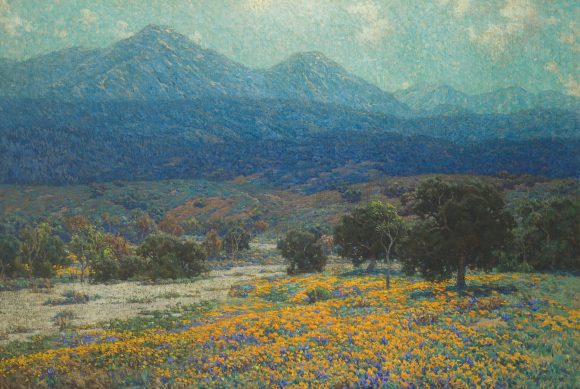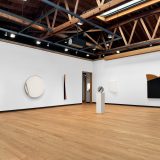The Light and Space Movement Combining the Momentary and the Permanent
March 10, 2017
The light and space movement originated in Southern California in the 1960’s and was directly influenced by California Impressionism in combination with the development of Minimalism in the 1960’s. The Light and Space movement focuses on utilizing light in order to create color and form, similar to the technique used by California Impressionists. Prominent artists in the Light and Space movement include Mary Corse, James Turrell, and Doug Wheeler. Other artists in the Chapman collection, including Sam Francis and Eric Orr, were influenced by the Light and Space movement.

Eric Orr,
Shadow
, 1989. Oil on canvas, 13″ X 11″. Gift of Anton Segerstrom. Escalette Permanent Collection of Art, Chapman University.
California Impressionism, also known as California Plein Air painting, developed in the early 20th century. This group of impressionists created a distinctive art form that combined American and European traditions. The California Impressionists worked en plein air, painting on easels outside while looking at the natural landscape. Working outside allowed these artists to focus on the vast expanse of the natural landscape, observing the way the sunlight affected the color and form of the surrounding area. The impressionists’ work was momentary and captured the California landscape under specific conditions at a singular point in time. The California Impressionists’ focus on the intersection of time, light, and color later caught the eye of minimalist artists in the 1960’s.

Granville Redmond,
California Poppy Field
, 1926. Oil on canvas, 40 1/4″ X 60 1/4″. LACMA, Los Angeles. https://collections.lacma.org/node/227963
Minimalism developed out of the Abstract Expressionist movement in the 1960’s. The goal of minimalist artists was to change the previously imposed rule that art needs to contain aesthetic beauty and meaning. Minimalists valued simplicity and they created art that simplified shape into its basic form. The addition of light to the minimalist methodology allowed for their artwork to live within the present moment.
When minimalist artists adopted the use of light and color from California Impressionists, a new art form was founded. The Light and Space movement incorporates both two- and three-dimensional space in combination with natural and artificial light sources. The movement combines the timelessness of minimalism with the momentary nature of impressionism. Art in the light and space genre eternally exists in the present moment, accomplishing this through the presence of light in combination with the permanence of either space or the painted canvas.
Artists such as Mary Corse rely upon extreme two-dimensionality and a limited color palette to let natural light and the environment be present in their work. Instead of adding color to her pieces, such as Untitled (pictured below), Corse works in all white and adds glass micro-beads to the surface of her canvas. The micro-beads allow light to reflect off of the surface of the canvas and produce an array of colors and forms. For Corse the white canvas and the glass micro-beads are permanent and minimal. The way the light, both natural and artificial, shines off of the beads is momentary, capturing the time of day, weather, and encompassing environment.

Mary Corse,
Untitled
, 1986.Oil on canvas with glass micro-beads, 78″ X 102″. Gift of Jerome and Irene Barr. Escalette Permanent Collection of Art, Chapman University.
The light and space movement is a culmination of California impressionism and minimalism. Allowing for light and space artwork to capture both the permanence of the physical canvas or space in combination with the momentary and changing nature of light.
All text and images under copyright. Please contact collections@chapman.edu for permission to use. Information subject to change upon further research.


